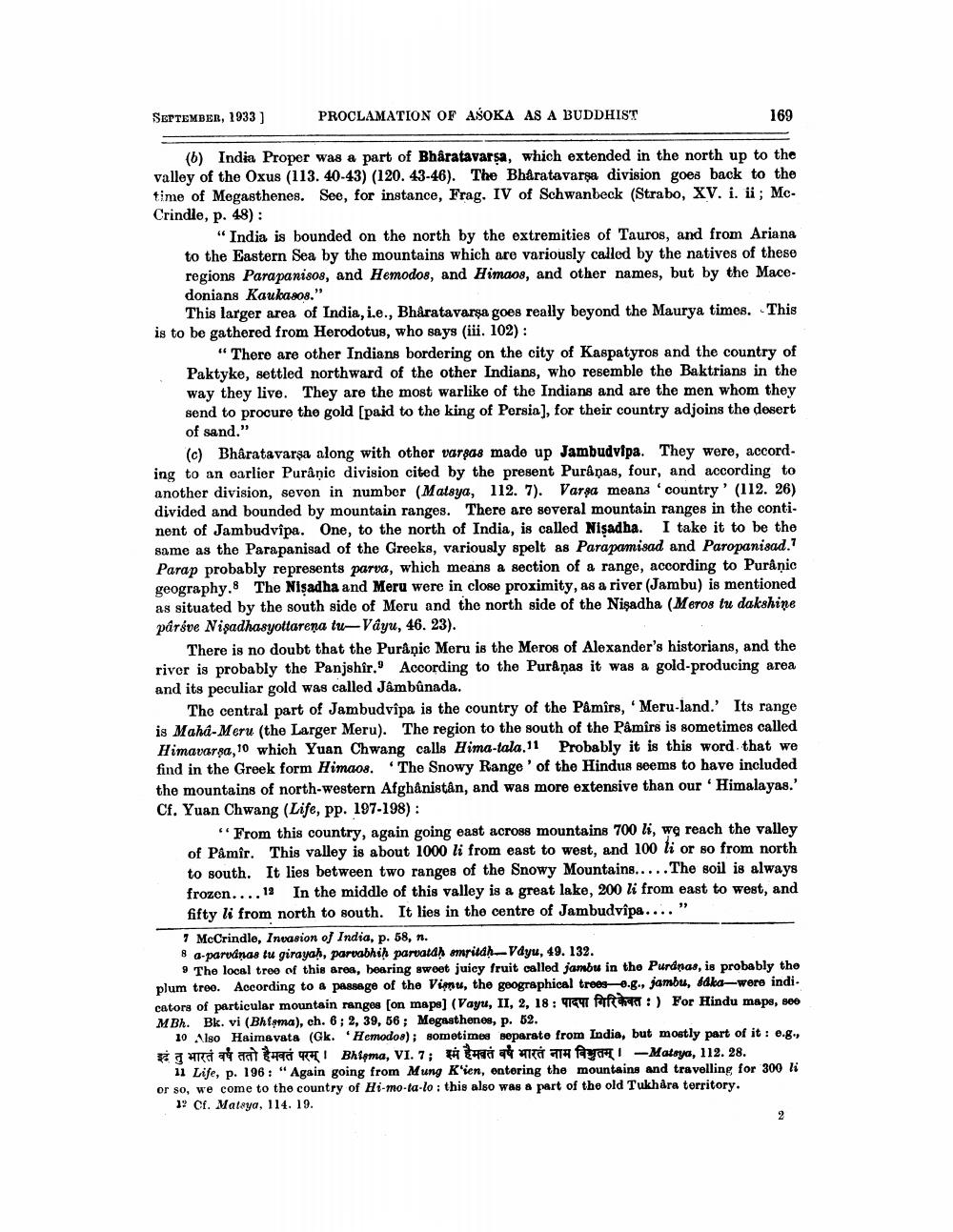________________
PROCLAMATION OF ASOKA AS A BUDDHIST
(b) India Proper was a part of Bharatavarsa, which extended in the north up to the valley of the Oxus (113. 40-43) (120. 43-46). The Bharatavarșa division goes back to the time of Megasthenes. See, for instance, Frag. IV of Schwanbeck (Strabo, XV. i. ii; McCrindle, p. 48):
SEPTEMBER, 1933]
169
"India is bounded on the north by the extremities of Tauros, and from Ariana to the Eastern Sea by the mountains which are variously called by the natives of these regions Parapanisos, and Hemodos, and Himaos, and other names, but by the Macedonians Kaukasos."
This larger area of India, i.e., Bharatavarsa goes really beyond the Maurya times. This is to be gathered from Herodotus, who says (iii. 102):
"There are other Indians bordering on the city of Kaspatyros and the country of Paktyke, settled northward of the other Indians, who resemble the Baktrians in the way they live. They are the most warlike of the Indians and are the men whom they send to procure the gold [paid to the king of Persia], for their country adjoins the desert of sand."
(c) Bharatavarsa along with other varsas made up Jambudvipa. They were, according to an earlier Purânic division cited by the present Purâņas, four, and according to another division, seven in number (Matsya, 112. 7). Varga meana 'country' (112. 26) divided and bounded by mountain ranges. There are several mountain ranges in the continent of Jambudvipa. One, to the north of India, is called Nișadha. I take it to be the same as the Parapanisad of the Greeks, variously spelt as Parapamisad and Paropanisad." Parap probably represents parva, which means a section of a range, according to Purânic geography. The Niṣadha and Meru were in close proximity, as a river (Jambu) is mentioned as situated by the south side of Meru and the north side of the Nisadha (Meros tu dakshine parive Nipadhayettarena tu-Váy, 46, 23).
There is no doubt that the Puranic Meru is the Meros of Alexander's historians, and the river is probably the Panjshir." According to the Purâņas it was a gold-producing area and its peculiar gold was called Jâmbûnada.
The central part of Jambudvipa is the country of the Pâmîrs, 'Meru-land.' Its range is Maha-Meru (the Larger Meru). The region to the south of the Pâmîrs is sometimes called Himavarsa, 10 which Yuan Chwang calls Hima-tala.11 Probably it is this word that we find in the Greek form Himaos. The Snowy Range' of the Hindus seems to have included the mountains of north-western Afghanistan, and was more extensive than our 'Himalayas.' Cf. Yuan Chwang (Life, pp. 197-198):
"
"From this country, again going east across mountains 700 li, we reach the valley of Påmir. This valley is about 1000 li from east to west, and 100 li or so from north to south. It lies between two ranges of the Snowy Mountains.....The soil is always frozen....12 In the middle of this valley is a great lake, 200 li from east to west, and fifty li from north to south. It lies in the centre of Jambudvipa...."
7 McCrindle, Invasion of India, p. 58, n.
8 a-parváņas tu girayaḥ, parvabhiḥ parvataḥ emritáḥ-Vayu, 49. 132.
9 The local tree of this area, bearing sweet juicy fruit called jambu in the Purdnas, is probably the plum tree. According to a passage of the Vimu, the geographical trees-e.g., jambu, sdka-were indi. cators of particular mountain ranges [on maps] (Vayu, II, 2, 18: 4 ft) For Hindu maps, see MBh. Bk. vi (Bhisma), ch. 6; 2, 39, 56; Megasthenes, p. 52.
10 Also Haimavata (Gk. Hemodos); sometimes separate from India, but mostly part of it: e.g., इदं तु भारतं वर्ष ततो हैमवतं परम् । Bhima, VI. 7; इमं हैमवतं वर्ष भारतं नाम विश्रुतम् । –Matsya, 112.28.
11 Life, p. 196: "Again going from Mung K'ien, entering the mountains and travelling for 300 li or so, we come to the country of Hi-mo-ta-lo: this also was a part of the old Tukhara territory. 12 Cf. Mataya, 114. 19.
2




